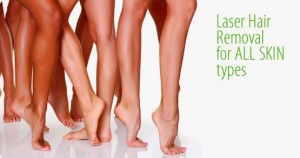
Unwanted facial and body hair is a common problem that can be a source of distress for both men and women.
- Excessive hair growth is classified as either hypertrichosis or hirsutism.
- Hypertrichosis is the excessive growth of body hair in a normal or abnormal pattern. It may be genetic or due to medications, hormones, malnutrition, tumors or metabolic problems.
- Hirsutism is excessive growth of hair in women, but in a male pattern — such as the beard, mustache or lower abdomen and may be due to hormonal problems, medications, tumors or heredity.
- Many treatment options for managing unwanted hair have been available over the years, such as shaving and waxing, but these methods are temporary and offer varying degrees of success.

In-office laser and light-based hair removal
- Doctors and Licensed Estheticians use lasers and light sources to safely and effectively treat larger areas of unwanted hair with minimal patient discomfort and fewer complications than other hair-reduction methods.
- Most lasers are equipped with a cooling device that reduces the discomfort from the laser light and also protects the top layer of skin from excessive heating and potential changes in pigmentation.
- Laser and intense pulsed light (IPL) devices send specific concentrated beams of light through the skin that are absorbed by the melanin (dark) pigment present in the hair follicle shafts.
- Because hair grows in cycles, repeated treatments are necessary to destroy the hair follicles.
- The ruby, alexandrite, diode and intense pulsed light systems were the first lasers approved by the U.S. Food and Drug Administration (FDA) for hair reduction.
- Treatments should be performed by or under the direct supervision of a physician or a licensed esthetician who is laser certified and has appropriate training and expertise.
- In general, three or more treatments are required to achieve permanent hair growth reduction.
- Patients seeking laser hair removal are advised to avoid tanning or sunless tanners and to use a broad-spectrum sunscreen for up to six weeks prior to treatment.
- The most common side effects include discomfort, swelling, and redness that last one to three days.
- The percentage of hairs removed per session varies by location on the body, with thinner-skinned areas (e.g., armpits and bikini area) generally responding better than thick-skinned areas (e.g., back and chin).
- About 10 percent to 25 percent reduction in hair growth can be expected with each treatment.
- Treatments are repeated every four to eight weeks.
- The hair that regrows following treatment tends to be lighter and finer in texture.
- Patients are instructed to avoid sun exposure and to use a broad-spectrum sunscreen with a Sun Protection Factor (SPF) of 30 or higher following the procedure.
